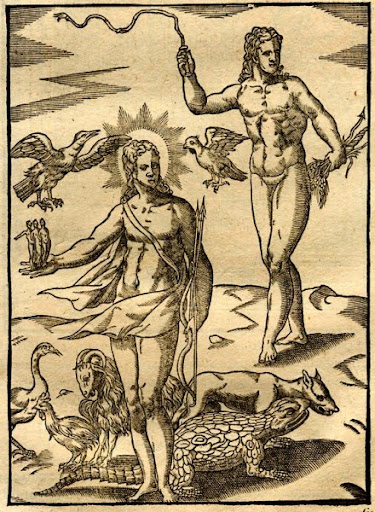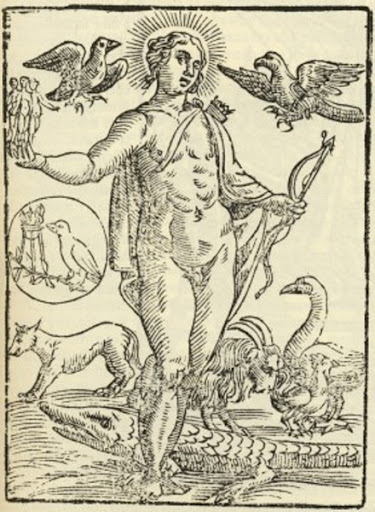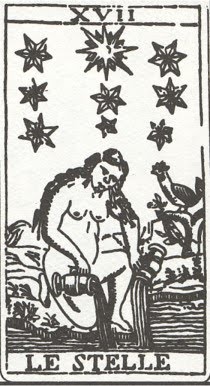Beanu: I was assuming that by "Venus" Rocco was referring to the planet Venus, not the goddess, and specifically to its manifestation as the Morning Star as referred to in Rev. 22, "the bright morning star," Christ as the herald of the New Jerusalem. In that regard, the Phoenix is the same, making way for the light "brighter than any day," as I think Revelation says.
The way the goddess Venus relates to the two jars, forgetting and remembering, is by her two aspects, Venus Urania and Venus Pandemos, in Plato's Symposium, the Celestial Venus of the water of Mnemosyne and heaven, and the Common Venus of Lethe and a return to earth in a new incarnation. Botticelli's "Birth of Venus" is of Venus Urania, daughter of Gaia and Uranos; "Primavera" is of Venus Pandemos (Pandemos = of all the people), daughter of Jupiter and some nymph, I forget who. Both refer to Venus as the Evening Star. Venus Urania's birth is about the fall of spirit into matter, for Plato the darkness of this world. Venus Pandemos is about fertility, sexual love, and the cydle of death and regeneration in this world.
Another painting, this time in the 16th century by Titian, is the one that in the 18th century got the title "Sacred and Profane Love." The title isn't accurate, but it captures the importance that people gave to the two Venuses.
The process of "forgetting and remembering" introduced by Pausanias and Dante is more complex in practice than I have so far presented. I am working on a post explaining it more fully.
I have been looking at images and texts about the Phoenix. A really good site is
http://bestiary.ca/beasts/beastgallery149.htm. There are 24 manuscript images of the Phoenix(counting one double image, the phoenix at different times, as 2) , plus lengthy historical quotes. 9 of them don't show the phoenix anywhere near any flames. If there are any tufts I can't see them; and they aren't very colorful, not much like peacocks.
I think now that rather than Pliny, I should have quoted Isidore of SevileL who gives fewer details than Pliny:
"Isidore of Seville [7th century CE] (Etymologies, Book 12, 7:22): "The phoenix is a bird of Arabia, which gets its name from its purple (phoeniceus) color; or because it is singular and unique in the world and the Arabs call singular and unique phoenix. It lives for 500 years or more. When it sees that it has grown old it builds a pyre for itself from spices and twigs, and facing the rays of the rising sun ignites a fire and fans it with its wings, and rises again from its own ashes." (
http://bestiary.ca/beasts/beast149.htm)
As far as phoenix vs. eagle. There is a myth about the eagle that fits: the eagle takes Ganymede to Olympus so he can be the cup-bearer, i.e. Aquarius. But I don't think the central figure on the card is going anywhere, she's doing her job where she is. Also, I think a dry and hot bird is more appropriate than a wet and cold one. Wet and cold, earth and water, are well represented in the bottom half of the card already, as for example in the Noblet. Nothing more is needed. What the Dodal etc. do is draw a connection between the hot and dry top half and the bottom half, and at the same time suggesting what the future has in store for someone who driniks of the streams. So now I am looking at medieval-Renaissance depictions of other solar birds as well as the phoenix. I have found one interesting one in Cartari, which I would love to hear people's take on. I will put it up later, in a separate post, once I have scanned it and translated the Italian text (to the best of my meager ability).
Bea and Beanu: Egyptian-derived images are fine with me as long as they are Greek-Roman-medieval-Renaissance (any of those) in form and use images, language, and conceptions known in the 17th century, as opposed to terms known only after hierolyphics were understood correctly or images buried in tombs or volcanic ash.
Rocco: It seems to me that what is relevant is not the "intentions of the artist" nor how later, differently informed times would have seen the images, but rather how educated people of the time would have responded to the image. My sense is that there were two main uses of the cards. First, to play a trick-taking game, and second, educational. In trick-taking games, the way to win is to remember what cards have been played: deduction, in other words. (the "Grand Robert" French dictionary, 1985, says that the word "tarot" derives from an Arab word meaning deduction (in French, meaning deduction or inference. I don't know where that comes form, but I like it.) The "art of memory" was to construct memorable narratives that would bring to mind the cards so encoded. Later this art got transferred to fortune-telling. The more associations one had, the better one's memory.n And in divination, the more associatons, the more open one's intuition to various symbolic possibilities as they relate to the other cards and the person in front of one. Little details become important here (see for example Jodorosky's
La Via del Tarot, as it is called in my Spanish translation).
The second purpose was educational, as seen in the "Tarot of Mantegna" and the "Labyrinth" game (and also the bird decks). Primary would be instruction in the Christian faith: hence wew have encoded Christian images and a sequence suggesting the road to Christian salvation. For more educated people, it would also serve to teach Greco-Roman mythology as precursors to Christianity, including Egyptian and other myths known at the time. A parent or governess could play the game with his or her child and give instruction at the same time, or test the child on his or her knowledge. That is where things like size and shape come in, and the habits of various birds, as they relate to the overall meaning of the card. Or so I like to think. I certainly use the cards that way!








